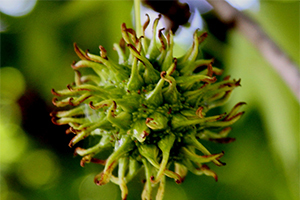Liquidambar orientalis


Other common names
Turkish: Gunluk agaci.
Origin of the species name
Liquidambar is from Latin referring to the tree's resin; orientalis is Latin for east and refers to its eastern origin (it was the most eastern species known at the time of its scientific naming (1768).
Family
Altingiaceae
Date planted
September 2009
Lifespan
Trees of this species can live 130 years or more.

General description
This is a small deciduous tree with a thick reddish grey bark and numerous branches. It has 5-lobed, glossy leaves and an attractive autumn display. The white flowers are insignificant and are followed by clusters of woody, burr-like fruit capsules. Height 10m Spread 4m.
Natural distribution and habitat
The species is native to the eastern Mediterranean area, in southern Turkey on valley floors and up mountain sides where it occurs mainly on flood plains, marshy places and valley sides near streams up to elevations of 1800 metres, often as pure stands.
Conservation status
Although it is not classified as a threatened species, the area of the native forests has reduced significantly. Among the main causes for the loss of sweet gum forests was the cutting and felling of trees to open new fields for agriculture, as well as the construction of dams at localities which flooded habitats for the species.
Planting pattern
Planted in a diamond grid pattern. The five radiating alleys are reminiscent of the major veins of the leaf.
Uses
The extraction of the aromatic resin 'storax' plays an important role in local economies. The resin has a multitude of uses, including medicinal – it is one of the ingredients of Friars Balsam – and is also used in many external applications for abrasions, anxiety, bronchitis, catarrh, coughs, cuts, ringworm, scabies, stress-related conditions and wounds. It is also used in soaps, perfumery, cosmetics chewing gum and a stabiliser for cakes. The bark is burnt as an incense and the leaves, fruits and roots also have uses.
